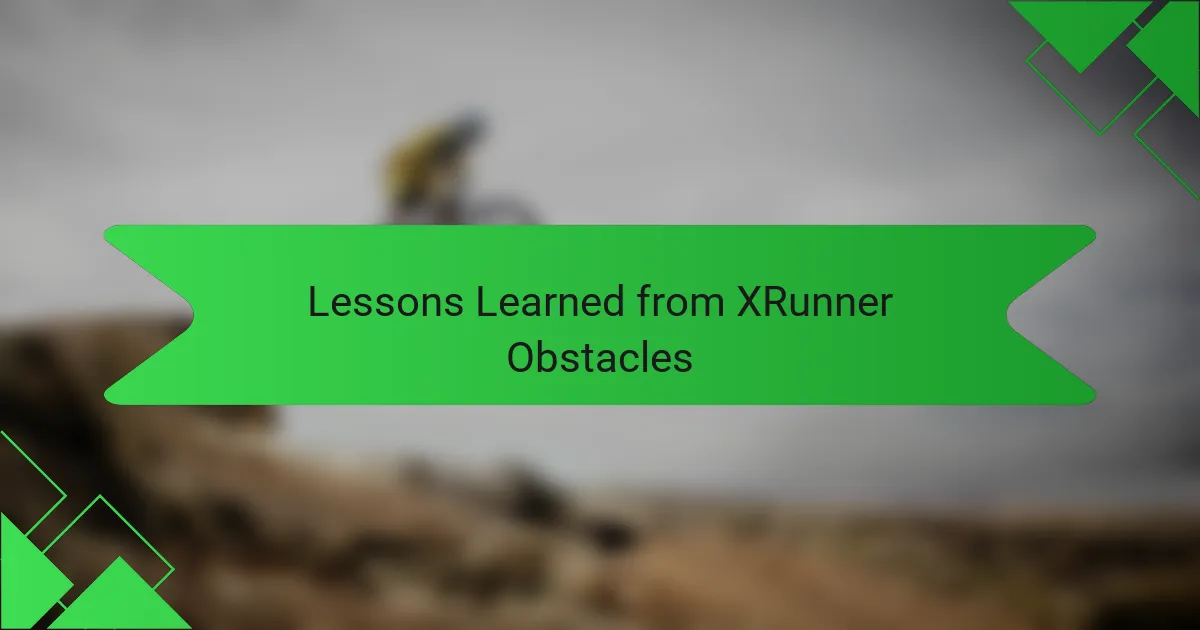Key takeaways
- Obstacle course racing combines running with diverse physical challenges that enhance strength, endurance, and mental toughness.
- XRunner courses emphasize teamwork and communication, with varied terrain and obstacles that maintain engagement and excitement.
- Preparation should include functional strength training, practice on uneven surfaces, and strategic pacing to optimize performance.
- Key lessons include the importance of adaptability, mental resilience, and the value of collaboration in overcoming challenges.

What is Obstacle Course Racing
Obstacle course racing is a thrilling blend of running and physical challenges that test your strength, endurance, and mental grit. From my experience, it’s not just about speed but also about overcoming fear and pushing past limits, which makes every race incredibly rewarding.
I remember my first XRunner race vividly—the adrenaline rush as I tackled walls and crawled under nets was unlike anything else. Each obstacle demanded a different skill, and conquering them gave me a real sense of accomplishment.
- Running over uneven terrain including mud and rocky paths
- Climbing over walls and ropes
- Crawling under barbed wire or nets
- Carrying or dragging heavy objects
- Jumping across balance beams and other unstable surfaces
- Balancing and coordination challenges
- Navigating through water or mud pits
This variety is what keeps the race exciting and unpredictable, ensuring no two courses feel the same.

Overview of XRunner Obstacle Courses
XRunner obstacle courses offer a unique blend of challenging physical elements and engaging teamwork activities. From my experience, the variety keeps you on your toes—just when you think you’ve mastered one type of obstacle, another surprises you. I really appreciated how the courses pushed my limits without feeling overwhelming, striking that perfect balance between fun and intensity.
| Feature | XRunner Obstacle Courses |
|---|---|
| Course Variety | Multiple terrain types with varied obstacles |
| Difficulty Level | Moderate to challenging, suitable for most fitness levels |
| Team Elements | Strong focus on teamwork and communication |
| Atmosphere | Energetic and supportive, encouraging competitors |
| Personal Experience | Engaging and rewarding, with moments that tested both strength and strategy |

Preparing for XRunner Races
Preparing for XRunner races took a bit of trial and error for me. I quickly learned that stamina alone wouldn’t cut it; I had to build strength and agility too. There was this one race where I underestimated an obstacle that required a lot of upper-body strength—I struggled more than I expected, which taught me a valuable lesson.
From my experience, focusing on a few key areas really helped me tackle the course with more confidence:
- Incorporate functional strength training, especially pull-ups and grip exercises
- Practice running on uneven terrain to simulate race conditions
- Work on explosive movements like jumps and sprints to power through obstacles
- Build endurance with interval training to handle bursts of effort
- Test gear and shoes in advance to avoid surprises on race day

Highlights from My XRunner Experience
One of the standout moments for me was conquering the wall climb near the halfway point. I remember pausing for a split second, wondering if I could pull myself up, but once I did, that surge of pride was unforgettable. Have you ever felt that mix of doubt and exhilaration all at once? That’s what makes XRunner so addictive.
Another highlight was navigating the muddy terrain—it wasn’t just about getting dirty, but about maintaining balance and focus when everything felt slippery and unstable. I never thought mud could be such a serious challenge until I slipped a few times! Those moments tested my coordination more than I expected.
What really stuck with me, though, was the way the course mixed physical effort with mental strategy. Deciding when to push hard or when to conserve energy felt like a game of chess on the move. It reminded me how obstacle racing isn’t just a test of strength, but a test of smarts too.

Challenges Faced During Races
Challenges during XRunner races pushed me beyond my limits. The slippery mud tested my balance, and muscle fatigue really set in by the final obstacle. I remember struggling with the rope climb—the grip strength required was intense, and it left me feeling both frustrated and determined.
| Challenge | My Experience |
|---|---|
| Slippery Mud | Lost footing multiple times, making me cautious but more focused |
| Muscle Fatigue | Legs burned near the end; pacing was crucial to keep going |
| Rope Climb | Grip strength was the biggest hurdle; felt a mix of frustration and motivation |

Tips for Succeeding in XRunner
I found that pacing myself carefully during XRunner made a huge difference. It’s tempting to sprint early on, but saving energy for the tougher obstacles really helped me avoid burnout. Also, pay close attention to your footing—slippery surfaces caught me off guard a couple of times.
| Tip | Why It Helps |
|---|---|
| Pace Yourself | Prevents early fatigue and helps with endurance during difficult sections |
| Watch Your Footing | Reduces risk of slips and injuries, especially on wet or uneven obstacles |
| Use Momentum | Makes overcoming obstacles smoother and less tiring |

Lessons Learned from XRunner Obstacles
One key lesson I took from XRunner obstacles is the importance of adaptability. Each challenge demanded a different approach—what worked for climbing a rope didn’t help much with balancing across a beam. Have you ever been caught off guard like that? It taught me to stay flexible and think on my feet rather than relying on one strategy.
Another big takeaway was realizing how mental strength can sometimes matter more than physical power. There were moments when my body felt exhausted, but pushing through the doubt and exhaustion made all the difference. That feeling of conquering a tough obstacle after battling your own mind is incredibly empowering.
Lastly, teamwork isn’t just a nice bonus—it can be a game-changer. There were times when a helping hand or timely encouragement from fellow racers made obstacles feel less intimidating. It reminded me that while these races test individual grit, they also highlight the strength found in collaboration. Have you experienced that unexpected boost from a teammate? It’s something I’ll never forget.
